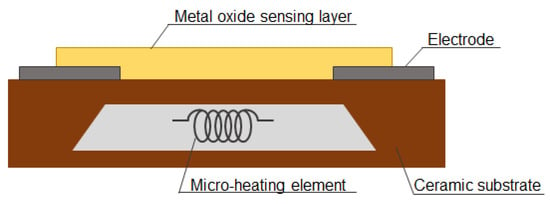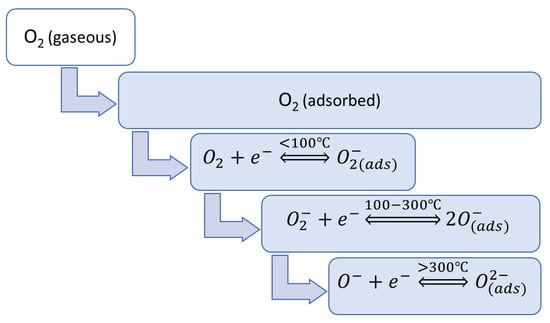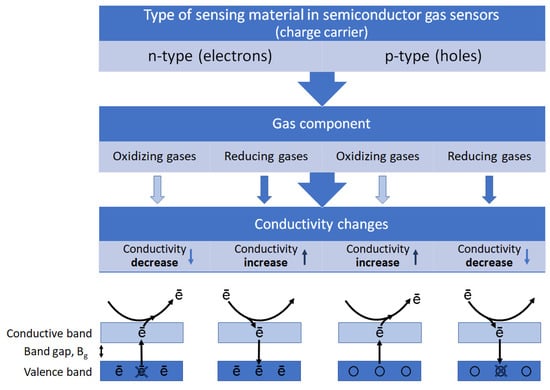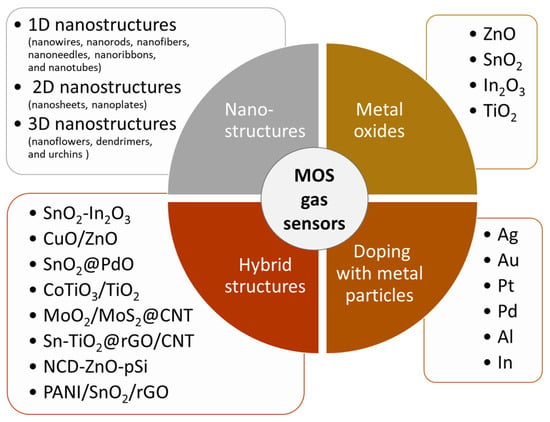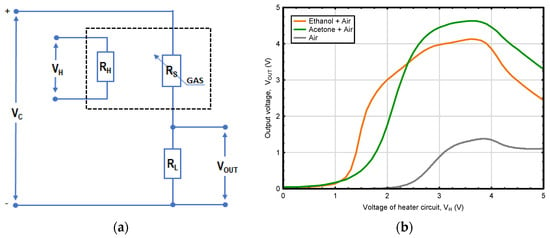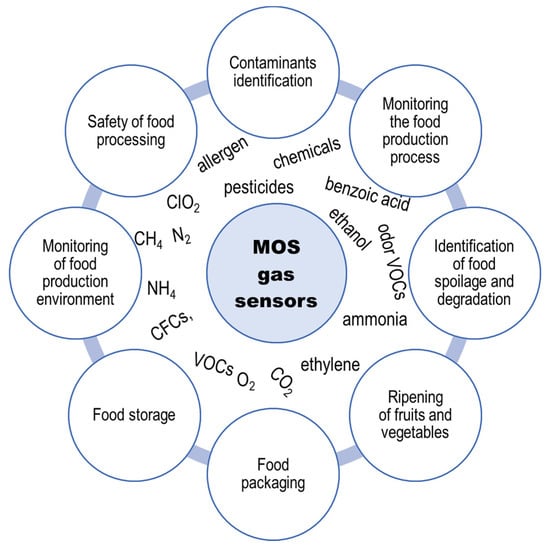3.2. Sensor Thermal Modulation
Despite considerable efforts made to improve MOS gas sensors by sensing material modification, the widespread application of these devices is still hampered by their constrained selectivity [
110]. Therefore, in order to enhance their performance, ongoing research and development also focused on optimizing measurement methodologies for MOS gas sensors [
158]. The starting point for these considerations is the estimate of the optimal operating temperatures of the gas sensor for various gas molecules. Previous investigations showed that for different gas components, the maximum level of voltage response is often achieved at different sensor operating temperatures. Research by Karmakar et al. [
159], examining a gas sensor based on nanocrystalline particles of barium hexaferrite (BaFe
12O
19), a material with excellent magnetic properties and stable crystalline structures regardless of temperature [
160], showed that the sensor exhibited the maximum response to acetone and ethanol vapors at different temperatures of 325 °C and 375 °C, respectively. As a result, in recent years a promising approach to enhance selectivity of MOS gas sensors has emerged through the development of a measurement technique involving thermal modulation of sensor heater [
5]. This advancement opens up promising possibilities for applications that require the precise detection of individual components within gas mixtures [
6,
161]. The thermal modulation approach turns in the adjustment of input voltage applied to the gas sensor heater, which dynamically changes the sensor operating temperature, offering valuable insights into the kinetics of surface processes [
162,
163]. In a measurement methodology using this modulation technique, the responses of a single MOS gas sensor can be likened to the action of multiple gas sensors of the same type operating at different temperature levels. Temperature fluctuations modify the intensity of electron transitions from the forbidden to the allowed band and affect adsorption and redox reactions occurring on the surface of the sensing material, thus influencing sensor resistance (R
s) (
Figure 6a). Changes in this resistance, recorded as a function of heater voltage V
H, create comprehensive characteristics (
Figure 6b and
Figure 7), providing complex insight into the composition of the mixtures under examination [
5]. Moreover, the variation in the waveforms recorded for gas mixtures can be treated as a “fingerprint” containing encoded information about the type and concentrations of its gas components (
Figure 7).
Figure 6. (
a) The diagram illustrates the measuring system for the TGS2610-C sensor with temperature modulation, with R
S representing the sensor resistance, R
L denoting the resistance of an auxiliary resistor, V
C and V
H indicating the voltages of the sensor circuit and micro-heater circuit, and V
OUT signifying the voltage associated with the sensor resistance R
S [
5]; (
b) the voltage output signal of the TGS2610-C gas sensor, with temperature modulation examined for pure air and of individual analytes: acetone and ethanol with a content of 0.5% [
5].
Figure 7. (
a) V
OUT waveforms, showing the response voltage of the TGS2610-C gas sensor with temperature modulation along with linear increasing in the voltage of the micro-heater at rates of 0.5 V per minute, recorded separately for different concentrations of (
a) ethanol alone, (
b) ethanol in presence of one level of acetone (0.5%), (
c) acetone alone, and (
d) acetone in presence of one level of ethanol (0.5%) [
5].
Previous research has shown that the interpretation of the response signal recorded by a thermally modulated sensor can be helpful in the quantitative analysis of molecules present in the mixture. Shi et al. [
164] obtained high-quality and -quantity recognition of four alcohol homolog gases (100% accuracy) using a dynamic measurement method with ZnO-based MOS gas sensors. Similarly, Krivetskiy et al. [
158], using the above-mentioned measurement technique, observed an improved discrimination of chemically related gases, i.e., methane and propane, within a concentration range of 40 to 200 ppm. They accomplished this result under varying real-world atmospheric conditions by employing metal oxide gas sensors based on nanocrystalline SnO
2 modified with Au and Pd that were subjected to temperature modulation. The authors indicated that a single-sensor thermally modulated gas detection device can be considered as a potential replacement for array-based electronic nose systems in many applications. In another study, Bora and Sarma [
165] carried out research, in which they attempted to enhance selectivity of MOS gas sensors by altering the sensor surface temperature. For this purpose, the authors designed a temperature modulation circuit based on pulse width modulation (PWM) to control and adjust the temperature of MOS gas sensors. This resulted in varied signature response patterns from the sensors, which can be harnessed to differentiate between individual gases.
The response of the thermally modulated gas sensor contains information on the composition of the analyzed gas mixture; however, it takes unique, complex patterns in the form of waveforms; therefore, their interpretation requires the use of relevant signal processing techniques. Among the methods used to recognize the response patterns, and hence classify substances contained in the analyzed gas mixture, principal component analysis (PCA) [
161,
163,
166] or partial least squares (PLS) regression [
167] are often applied. In some cases, PCA or linear discriminant analysis (LDA) are used to recognize the output signal in combination with other machine learning methods, such as k-nearest neighbor (KNN), logistic regression (LR), support vector machine (SVM), or the random forest algorithm (RF) [
162,
164,
168,
169]. Since the interpretation of output signals of thermally modulated MOS gas sensors is a key step determining the detection quality and significance of the obtained results, considerable attention has been paid to the development of algorithms aimed at deciphering sensor response patterns. The study by Krivetskiy et al. [
158] demonstrated that employing statistical shape space pre-processing on temperature-modulated signals from metal oxide gas sensors leads to an enhanced ability to identify gases. This improvement is particularly notable when using an artificial neural network (ANN)-based machine learning algorithm, surpassing the performance of previously reported signal processing techniques, such as principal component analysis (PCA), discrete wavelet transforms (DWT), polynomial curve fitting, and data normalization. Recently, the concept of integrating signal processing with nonlinear calibration and machine learning techniques has gained importance and is seen as a promising path to improve selectivity and accuracy of detection in real atmospheric conditions [
158,
170,
171,
172,
173]. This approach was adopted in a study aimed at developing a methodology for measuring and processing the output signal from a thermally modulated MOS gas sensor, using a B-spline curve and artificial neural networks (ANNs) [
5]. The proposed two-stage methodology facilitated quantitative analysis of volatile components present in mixtures containing ethanol and acetone.
In the initial phase, B-spline, which is a function described piecewise by polynomials and approximates complex dependencies, was used to extract relevant information from the gas sensor output signals, taking the form of complex, unique patterns (Figure 7). In the second stage, parameters being the control points shaping the B-spline curve were used as an input vector to the ANN model with a multilayer perceptron structure. The results showed usefulness of combining the B-spline (which effectively reduced the size of the measurement data set while retaining its most important features) and ANN modelling techniques to enhance response selectivity from a thermally modulated MOS gas sensor. The considered approach showed the possibility of extending the potential applications of single, thermally modulated gas sensors in the quantitative analysis of gas mixtures.
3.3. MOS Gas Sensor Arrays
The measurement accuracy and selectivity of gas sensors exposed to a multi-component gaseous environment can also be enhanced through the development of devices inspired by the human olfactory system, the so-called electronic noses (E-noses). The E-nose design includes two fundamental elements: (1) the sensor chamber containing the olfactory element in the form of an array comprising various odor detectors, which can respond to a wide variety of chemical molecules, and (2) the output unit equipped with a signal transformation system containing pattern recognition algorithms [
51,
174]. Similarly, as in the case of a single sensor, the main principle of E-nose operation is the oxidation-reduction reaction of gas on the surface of sensors. Each sensor in the E-nose array responds differently to various gases, and the collective response pattern provides a unique “fingerprint” for the mixture of gas components [
175]. Then, once the initial electrical signal is recorded, in further steps, it is transformed using statistical data analysis and pattern recognition algorithms, which play a crucial role in decoding the signal, as well as recognizing and classifying data information. As E-nose responses have the multidimensional nature, data analysis necessitates the use of advanced statistical methods. Among them, the most commonly used are the principal component analysis (PCA) [
176,
177,
178], linear discriminant analysis (LDA) [
168,
179], partial least squares discriminant analysis (PLS-DA) [
167,
170], and
k-nearest neighbor (KNN) [
180,
181,
182]. The statistical analysis is usually supported by machine learning algorithms utilizing random forest [
170,
172], support vector machines (SVM) [
180,
182,
183], artificial neural networks (ANN) [
170,
172,
184], and other artificial intelligence (AI) methods [
181,
185].
The electronic nose technique uses various types of sensors, including those based on metal oxides, semiconductive polymers [
51], quartz crystal microbalances [
186], and surface acoustic wave to detect and identify odors [
179]. Among them, MOS gas sensors are widely used in E-nose applications thanks to their numerous advantages, including high sensitivity, short response time, portability, accuracy, stability and durability, a broad response range, and low cost of manufacturing [
51,
175]. Despite their many advantages, MOS gas sensors also have some disadvantages, and one of the main ones is limited selectivity [
177]. Therefore, the incorporation of a group of various types of MOS gas sensors in the E-nose array, combined with significant advancements in sensor technology make it possible to enhance its sensitivity and selectivity in odor detection. Additionally, the integration of tools utilizing modern data analysis techniques has boosted precision and efficiency in interpreting sensor responses, thus improving its accuracy. However, like any technology, E-nose gas detection is not without some drawbacks. The primary mode of E-nose operation involves recognizing the entire gas mixture as a whole, rather than isolating individual gases within the mixture [
51]. As a result, even though the E-nose device is able to detect changes in the spectrum of volatile organic compounds (VOCs) and thus discriminate between classes or types of the tested sample, it is not capable of identifying specific chemical compounds, which is a significant limitation when detailed gas analysis is required [
177,
180,
182]. Moreover, VOCs constitute a numerous group; therefore, the design of an E-nose sensor array optimized for one application may not exhibit optimal performance when dealing with odors or gases present in other applications [
177]; hence, the design of these devices should be customized to particular applications and target gas compounds.
Despite its inherent limitations, the electronic nose technology has found wide applications in various sectors, including agriculture and forestry [
51,
167,
169,
184,
187], environmental pollutants detection [
181] and medicine [
183,
188]. The application of E-nose systems is particularly common in food industry [
168,
170,
172,
176,
189,
190,
191]. In the study by Teixeira et al. [
179], an E-nose consisting of nine SnO
2-based metal oxide sensors (TGS) proved to be a useful tool in classifying extra virgin olive oils according to the fruity intensity commercial grade. The olfactory sensor device employed in this study successfully detected various volatile chemicals responsible for the positive (e.g., fatty, floral, fruit, grass, green and green leaves attributes) and negative sensory attributes (e.g., sour and vinegary defects) of olive oil. The satisfactorily distinguished attributes of examined oils based on the perceived primary olfactory sensation and its intensity was carried out using both unsupervised techniques (principal component analysis) and supervised methods (linear discriminant analysis). Another study examining the applications of two E-noses adjusted for identifying synthetic flavors revealed that the designed arrays of MOS gas sensors can effectively respond to synthetic aromas [
177]. However, it was found that the used gas sensors had some performance shortcomings, as SnO
2-based MQ sensors proved unstable in testing larger numbers of samples and showed inconsistent responses with each iteration, while SnO
2-based TGS sensors produced a weak signal. The authors of the study suggested that the unstable response of MQ gas sensors could be caused by the temperature and humidity variations within the sensor chamber, the intensity of the sample aroma, and the unstable velocity of the carrier gas.
Recognizing and classifying response patterns are critical elements in the operation of a multisensor arrays; therefore, there is extensive research aimed at investigating discrimination techniques that can improve efficiency of gas detection systems. Xu et al. [
192] proposed a novel hybrid method for gas identification and its concentration detection, which was validated in modeled systems using CO and CH
4 samples. This approach used kernel principal component analysis (KPCA) to extract nonlinear characteristics of gas mixtures of various components. Subsequently, the recognition of the target gas was accomplished through the application of the K-nearest neighbor classification algorithm (KNN). Moreover, the method incorporates a multivariable relevance vector machine (MVRVM) to perform regression on the multi-input nonlinear signal, thereby detecting mixed gas concentration. Experimental results showed that the accuracy of the proposed method (98.33%) was better than the accuracy of principal component analysis (PCA) (92.50) and independent component analysis (ICA) (84.17%). However, the authors pointed out the need for further research on the identification and detection of multiple gas mixtures. In another study, in which an E-nose comprising seven MOS gas sensors was developed, different techniques for its response discrimination were applied, with the aim of identifying sources of milk (variety of dairy farms) and estimating milk quality indicators, specifically milk fat and protein contents [
168]. To identify the milk sources, the study leveraged features extracted from milk odor data obtained from the E-nose, as well as composition features derived from dairy herd improvement (DHI) analytical data. These features were subjected to principal component analysis (PCA) and linear discriminant analysis (LDA) for the purpose of dimension reduction. Subsequently, three machine learning algorithms, namely logistic regression (LR), support vector machine (SVM), and random forest (RF), were used to construct a classification model for milk source (dairy farm) identification. The results of that study indicated that the SVM model, based on fusion features post LDA, demonstrated the best performance, achieving an accuracy of 95%. Additionally, based on the E-nose, extracted features estimation models for milk fat and protein contents were developed using gradient boosting decision tree (GBDT), extreme gradient boosting (XGBoost), and random forest (RF) techniques. The outcomes indicated that the RF models outperformed the others, providing R
2 of 0.9399 for milk fat and R
2 of 0.9301 for milk protein. In turn, Liu et al. [
170] used four popular machine learning algorithms, namely extreme gradient boosting (XGBoost), random forest (RF), support vector machine (SVM), and backpropagation neural network (BPNN), to distinguish odors of different wines recorded using a portable E-nose with TGS MOS gas sensors. The obtained results showed that among the methods under examination, the BPNN exhibited the most outstanding performance with accuracy rates of 94% in identifying production areas and 92.5% in classifying varietals. In another study, Jiang et al. [
181] compared the EQBC-RBFNN technique (i.e., query by committee for radial basis function neural network), which followed human learning mechanisms, with various previously employed discriminant methods (LDA, BPNN, RBFNN, KNN, SVM) in the interpretation of responses of an E-nose equipped with SnO
2-based MOS gas sensors (TGS) in the detection of three types of indoor pollutant gases (benzene (C
6H
6), toluene (C
7H
8), and formaldehyde (CH
2O)). Data processing results proved that the EQBC-RBFNN technique improved the accuracy of E-nose classification.
Recent research shows that integrating thermally modulated MOS gas sensors into E-nose arrays can also improve detection efficiency of these systems. Such an effect was observed in a study by Machungo et al. [
180], in which contamination of maize varieties naturally and artificially infected with
Aspergillus flavus was monitored using a portable electronic nose system containing a sensor array equipped with twelve n-type metal oxide gas sensors thermally cycled over a temperature range of 260 °C to 340 °C. The used array included three palladium-doped sensors (SnO
2-Pd), three platinum-doped sensors (SnO
2-Pt), one silver-doped sensor (SnO
2-Ag), one copper-doped sensor (SnO
2-Cu), three undoped WO
3 sensors and an experimental sensor (Extype 1) with undisclosed manufacturer specifications. Interestingly, this sensor system has demonstrated the ability to detect a broad spectrum of volatile compounds, encompassing alkanes, alkenes, alkynes, alcohols, aldehydes, amines, mercaptans, partially halogenated hydrocarbons, volatile acids, and volatile aromatic compounds, with the lower detection limit of 1 part per million (ppm). The used electronic nose system exhibited significant ability to distinguish between aflatoxin-contaminated and uncontaminated samples, correctly recognizing 70% of them. The authors suggested that this measurement methodology could facilitate the initial selection of large numbers of samples and thus reduce their number for further, costly and time-consuming quantitative analyses. In a subsequent study, the same authors compared performance of three E-nose instruments, namely MOS gas sensors (Fox 3000), conductive polymer sensors (Cyranose 320), and thermally cycled metal oxide-doped semiconductor sensors (DiagNose) in the detection of volatile compounds characteristic to aflatoxin-contaminated corn naturally infected with
A. flavus [
182]. Cross-validated classification accuracy of the tested E-nose systems revealed that an E-nose equipped with doped MOS gas sensors with thermocycling was the most effective in detecting aflatoxin contamination in corn (accuracy ranged in 81–94% for DiagNose, 76 –79% for Fox 3000 and 68–75% for Cyranose).
Recent research shows that E-noses have proven to be valuable tools in various applications in odor detection and gas analysis; however, there is still a need to improve their performance that can be enhanced by selecting an appropriate pattern recognition algorithm and application of a new measurement methodology using thermal modulation of MOS gas sensors.
4. Application of MOS Gas Sensors in the Food Industry
Figure 8 depicts the most common application of MOS gas sensors in the food industry. The use of a MOS gas sensor is crucial to ensuring safety and quality of food products at various stages of its production and distribution. Apart from that, it facilitates the monitoring of compliance with regulatory standards, as it enables the identification of contaminants such as pesticides, chemicals, and allergens in food products. Research on the detection of two pesticides, i.e., cypermethrin and chlorpyrifos, in apple samples, using an E-nose equipped with ten MOS gas sensors supported by discrimination algorithms, including principal component analysis (PCA), linear discriminant analysis (LDA), and support vector machine (SVM), showed that the employed set of MOS gas detectors accurately identified pesticide residues in apple samples [
193].
Figure 8. MOS gas sensor applications in food industry.
Gas detection is also essential in the production of various food products like coffee [
194], beer [
172], cheese [
195], and wine [
170,
196], as well as baking processes [
197], in which monitoring the presence of various gases allows the assessment of correctness of production processes and product quality. Experimental results show that the developed E-nose system using SnO
2-based MOS gas sensors combined with six machine learning techniques (decision tree, random forest, XGBoost, SVM, convolutional neural network (CNN), and CNN+LSTM) achieves good performance in coffee aroma recognition [
194]. In the beverage industry MOS gas sensors are employed to monitor the quality of carbonated drinks and ensure consistent levels of CO
2 [
16]. In turn, the application of E-nose technology, in conjunction with ANN modeling, enables both qualitative and quantitative analysis of benzoic acid in cola-type carbonated beverages [
198]. These types of gas sensors proved to be the most suitable in classifying different beverages based on the level of ethanol or other attributes [
170,
172]. For example, an E-nose prototype containing nine QM and four TGS SnO
2-based MOS gas sensors combined with different regression methods (multiple linear (MLR) and non-linear regression methods (NMLR)), and machine learning techniques (RF, extreme learning machine (ELM) and ANN) were found to be effective tools for detecting the level of ethanol in the range of 4–8% in a high spectrum of beers (for ELV R
2 = 0.888) [
172]. Similar MOS gas sensors (six TGS SnO
2-based gas sensors) were used in the E-nose bionic system to detect the odors of various wines, followed by four machine learning algorithms (extreme gradient boosting (XGBoost), random forest (RF), support vector machine (SVM), and backpropagation neural network (BPNN)), which, based on the properties of wine, identified it in terms of production area, variety, vintage, and fermentation processes [
170]. The best results in identifying production areas and varietals were achieved by BPNN, while the best results in identifying vintages and fermentation processes were delivered by SVM.
Maintaining the right gas composition is critical to preserving the freshness and taste of food. In such applications, MOS gas sensors are used in the fruit and vegetable industry to monitor ethylene produced during ripening in order to control this process and extend shelf life of these products. Tyagi et al. [
184] developed an E-nose containing five SnO
2-based MOS gas sensors and one digital temperature and humidity (DHT) sensor to monitor fruit ripeness. The operation of the MOS sensors incorporated into a microcontroller board was supported by an artificial neural network (ANN) algorithm used for pattern recognition. The designed E-nose system demonstrated the capability to discriminate alterations in odor profiles during the ripening of bananas, apples, grapes, oranges, and pomegranates, successfully classifying these specific fruits into their respective ripeness categories with an average accuracy of 95%.
The use of gas sensors in monitoring the levels of oxygen (O
2) and CO
2 in food, such as modified atmosphere packaging (MAP), also helps to extend the shelf life of perishable products by controlling oxidation and microbial growth [
199]. In turn, the detection of specific volatile compounds, such as ammonia, ethylene, and VOCs, produced e.g., in the meat and seafood or agricultural industry can help identify the onset of spoilage or degradation [
200].
The food industry is subject to various regulations and standards related to food production environment. Gas detection systems can be applied to help food manufacturers comply with these regulations by ensuring that processing environments are free from harmful gases and contaminants. In this area, MOS gas devices found application in monitoring the presence of hazardous gases, such as CO
2, CO, CH
4, and NH
3, which can be released during food processing, storage, and transportation [
199]. Some food processing operations may also generate gases, such as greenhouse gases (e.g., methane (CH
4)) or ozone-depleting substances (e.g., chlorofluorocarbons (CFCs)) that can be harmful to the environment [
40]. According to the report of the Intergovernmental Panel on Climate Change (IPCC), food systems account for 23–42% of global greenhouse gas emissions [
201]. Therefore, MOS gas sensors can help in monitoring and controlling emissions and thus minimize the environmental impact of food production [
202].
MOS gas sensors can also be used to ensure that the concentration of sanitizing gases, such as chlorine dioxide (ClO
2), is within the required range to effectively disinfect food processing equipment and surfaces. In the case of specialty gases, such as nitrogen (N
2) used in food processing for cryogenic freezing, gas detectors ensure purity and consistency of these specialty gases, which are critical to the quality and safety of the final product. Gas detection systems often come with data logging and reporting capabilities that allow food manufacturers to maintain records of gas levels over time, enabling traceability and facilitating quality control audits. In the case of a gas leak or abnormal gas levels, gas detectors provide early warning systems that can trigger alarms and shut down equipment, preventing accidents and allowing for a prompt response and evacuation if necessary [
203].
